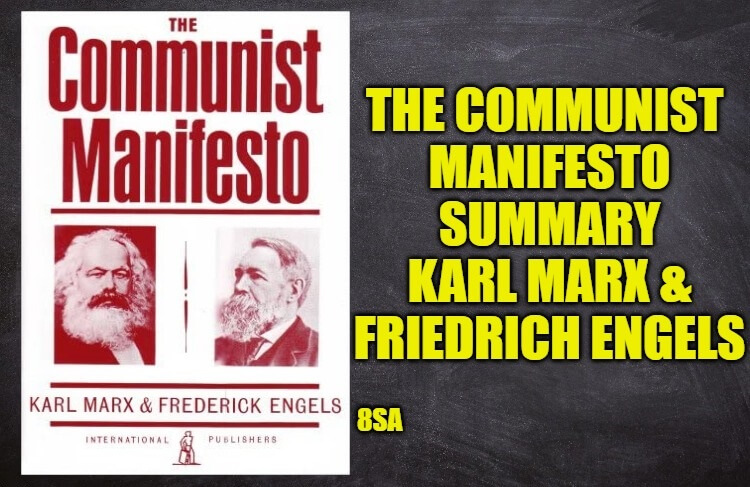The Communist Manifesto book summary written by Karl Marx and Friedrich Engels. Information about the theme and the summary of the book The Communist Manifesto.

The Communist Manifesto
The Communist Manifesto is a political pamphlet written by Karl Marx and Friedrich Engels in 1848. It is considered one of the most influential political texts in history, and it is the foundational document of the Communist movement.
The main theme of the Communist Manifesto is the idea of a classless society, where the means of production and distribution are controlled by the community as a whole, rather than by a small group of capitalists. Marx and Engels argue that the capitalist system is inherently exploitative, as it forces workers to sell their labor for wages, while the capitalists reap the profits. They argue that this exploitation will inevitably lead to a revolution, in which the working class (proletariat) will rise up and overthrow the capitalist class (bourgeoisie).
The Communist Manifesto also lays out a vision for the new society that will emerge after the revolution. Marx and Engels argue that this society will be based on the principle of “From each according to his ability, to each according to his need.” This means that everyone will work according to their abilities, and will be provided with what they need, regardless of their individual ability to pay.
The Communist Manifesto is also notable for its call to unite workers of all nations and its criticism of other political ideologies, such as liberalism, conservatism and socialism.
In summary, The Communist Manifesto is a political pamphlet that lays out the ideas of Karl Marx and Friedrich Engels about the exploitation of the working class under capitalism, and their vision of a classless society in which the means of production and distribution are controlled by the community as a whole.
Summary
The Communist Manifesto is a political pamphlet written by Karl Marx and Friedrich Engels in 1848. It is considered one of the most influential political texts in history and the foundational document of the Communist movement. The Manifesto was commissioned by the Communist League, a group of German workers and was first published in London in 1848.
The main theme of the Communist Manifesto is the idea of a classless society, where the means of production and distribution are controlled by the community as a whole, rather than by a small group of capitalists. Marx and Engels argue that the capitalist system is inherently exploitative, as it forces workers to sell their labor for wages, while the capitalists reap the profits. They argue that this exploitation will inevitably lead to a revolution, in which the working class (proletariat) will rise up and overthrow the capitalist class (bourgeoisie).
The Communist Manifesto begins by declaring that “the history of all hitherto existing society is the history of class struggles.” Marx and Engels argue that throughout history, society has been divided into different classes, with one class dominating and exploiting the others. They argue that in capitalist society, the bourgeoisie (the capitalist class) own the means of production (factories, land, etc.), while the proletariat (the working class) own nothing but their own labor power. They argue that this creates an inherent conflict between the two classes, and that the only way to resolve this conflict is for the proletariat to overthrow the bourgeoisie and establish a classless society.
The Communist Manifesto also lays out a vision for the new society that will emerge after the revolution. Marx and Engels argue that this society will be based on the principle of “From each according to his ability, to each according to his need.” This means that everyone will work according to their abilities, and will be provided with what they need, regardless of their individual ability to pay. They argue that this will eliminate the exploitation of the working class and create a society in which everyone is equal.
The Communist Manifesto also calls for the abolition of private property and the centralization of credit, communication and transportation in the hands of the state. They argue that this will allow the state to control the means of production and distribution and ensure that they are used for the benefit of the community as a whole. They also call for the abolition of the family, as they see it as a tool of capitalist oppression, and the creation of a new society in which men and women are equal and can freely choose their partners.
In addition to their critiques of capitalism, Marx and Engels also criticize other political ideologies, such as liberalism, conservatism and socialism. They argue that these ideologies are all based on the idea of protecting the interests of the bourgeoisie and that none of them can truly resolve the class conflict at the heart of capitalist society.
Finally, the Communist Manifesto concludes with a call for workers of all nations to unite and work together to overthrow capitalism and establish a classless society. The Manifesto argues that the workers of the world have nothing to lose but their chains, and that they have a world to win.
In summary, The Communist Manifesto is a political pamphlet that lays out the ideas of Karl Marx and Friedrich Engels about the exploitation of the working class under capitalism, the class struggle between the capitalist and the working class and the need for a classless society in which the means of production and distribution are controlled by the community as a whole. It also calls for the abolition of private property, centralization of credit, communication, transportation and the family in the hands of the state, it critiques other political ideologies and concludes with a call for workers of all nations to unite and work together to overthrow capitalism and establish a classless society.